Roadway Sign, Soldier Summit [DRGW Facilities PA]
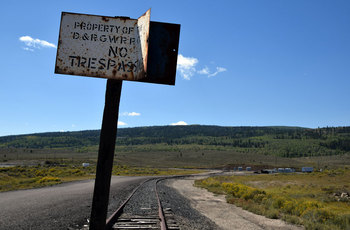 : Soldier Summit, UT Sep. 10, 2014
: Soldier Summit, UT Sep. 10, 2014I’m representing the Rio Grande remnants we found during our vacation in Utah.
Yellow flowers of Broom Snakeweed exploded at the crest of Soldier Summit. Here, one of the Rio Grande original signs was found at the end of wye.
According to the D&RGW Standard Plans, this is the “Roadway Sign”. I trimmed away the UP sign standing just next to this to capture the image.
D&RGW Standard Plans of Roadway Sign;
2015-01-24 09:00
コメント(0)
Helper Depot [DRGW Facilities PA]
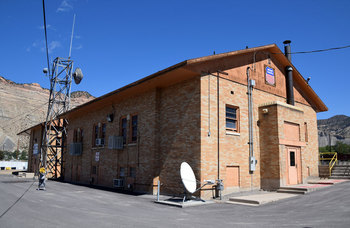 : South & West elevation
: South & West elevationThis is one of the Rio Grande original structures remaining along its route in Utah; the depot at helper.
Helper Depot was built in 1946 with cinder block and brick. It originally had flat roof: gabled roof today is a later addition*. It now houses office and crew room for Union Pacific Utah Service Unit: UP still assigns manned helpers on westbound coal trains. Amtrak California Zephyr makes a daily stop, but no agent is stationed at the depot.
All photos taken on Sep. 10, 2014.
* photo of the depot as built (without gabled roof);
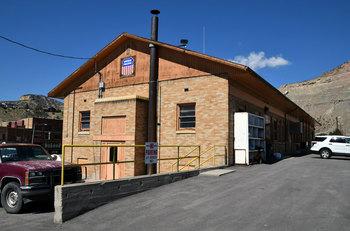 : South & East elevation
: South & East elevation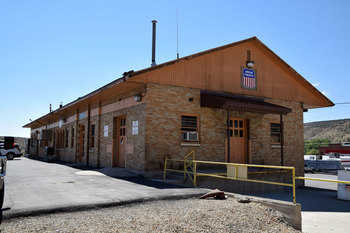 : North & East elevation
: North & East elevation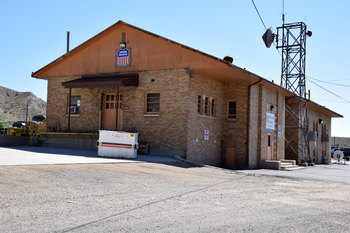 : North & West elevation
: North & West elevation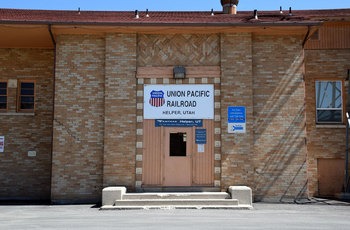 : passenger entrance doorway
: passenger entrance doorway2015-02-06 09:00
コメント(0)
Helper Enginehouse and Sand Tower [DRGW Facilities PA]
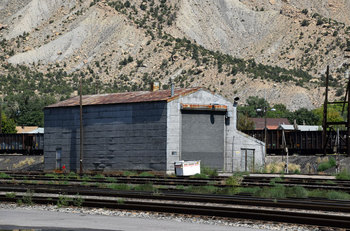 : Helper, UT Sep. 10, 2014
: Helper, UT Sep. 10, 2014This is one of the Rio Grande original structures remaining along its route in Utah; the enginehouse at helper.
This single stall enginehouse was the home of “Last of a Breed”s. It was brought from Sunnyside, Utah circa 1970. Large flying Rio Grande logo was once painted on the wall where you can see the white paint today. It seems unused maybe because the house lacks length for housing today’s big locomotives, or there isn't a maintenance crew any more.
The history of the vintage sand tower standing next to the enginehouse goes back to the steam era. According to Rio Grande in Color Vol. 2, the tower was manufactured by Ogle Machinery Co.
revised, Jun. 8, 2015
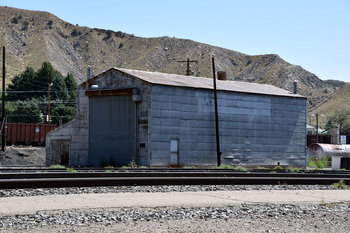 : Helper, UT Sep. 10, 2014
: Helper, UT Sep. 10, 2014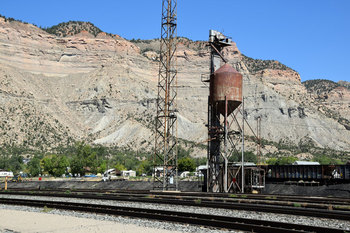 : Helper, UT Sep. 10, 2014
: Helper, UT Sep. 10, 20142015-02-07 09:00
コメント(0)
Signals, Helper and East [DRGW Facilities PA]
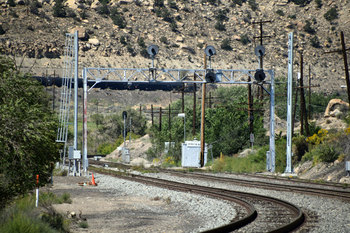 : Helper, UT Sep. 10, 2014
: Helper, UT Sep. 10, 2014According to ND Holmes of DRGW NET, Union Pacific is replacing the Rio Grande original signal system in Utah since 2010*. The photo above shows new signal bridge posts installed next to the original bridge, at the northernmost of the Helper yard. I surveyed the work progress east from Helper.
But it’s difficult to distinguish the Rio Grande original signal at a glance. My decision is based on the installation of side braces of snow shield; the Rio Grande original braces look radially from the front**.
As far as I saw, some original signals are still intact, but the successors are on the way as shown in the photos below; new posts and boxes are already installed.
A surplus Rio Grande original signal box is found along with caboose and boxcars at Big Rock Candy Mountain Resort.
* signal replacement photos by ND Holmes;
** D&RGW Standard Plans of Snow Shield for Color Light Signals;
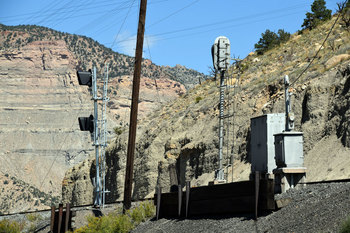 : Helper, UT Sep. 10, 2014
: Helper, UT Sep. 10, 2014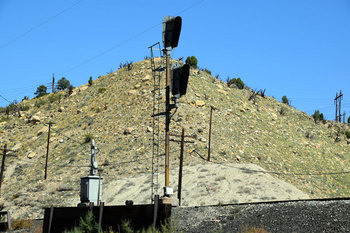 : Helper, UT Sep. 10, 2014
: Helper, UT Sep. 10, 2014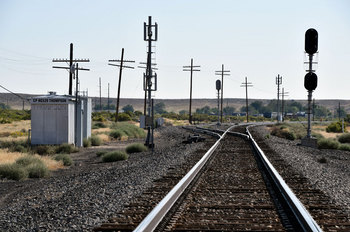 : Thompson, UT Sep. 11, 2014
: Thompson, UT Sep. 11, 2014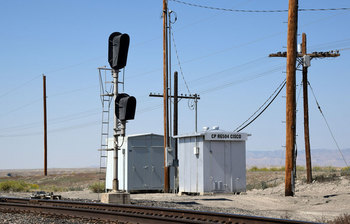 : Cisco, UT Sep. 11, 2014
: Cisco, UT Sep. 11, 2014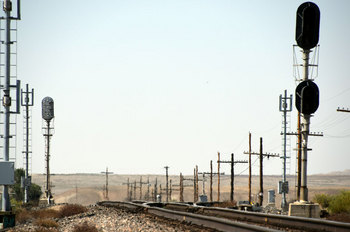 : Cisco, UT Sep. 11, 2014
: Cisco, UT Sep. 11, 2014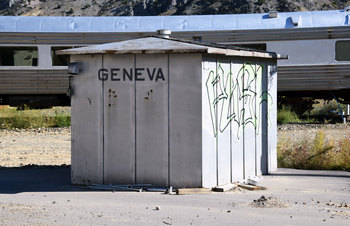 : Sevior, UT Sep. 15, 2014
: Sevior, UT Sep. 15, 20142015-02-08 09:00
コメント(0)
Green River Depot [DRGW Facilities PA]
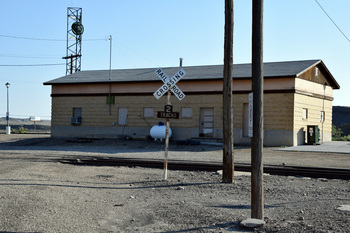 : north & west elevation
: north & west elevation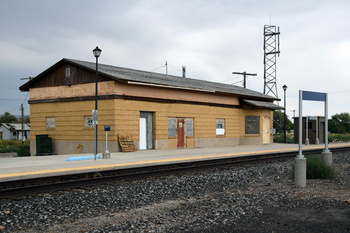 : west & south elevation
: west & south elevation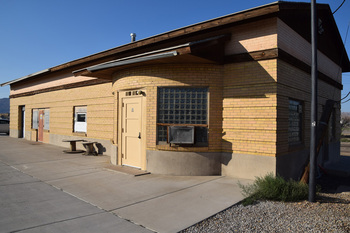 : south & east elevation
: south & east elevation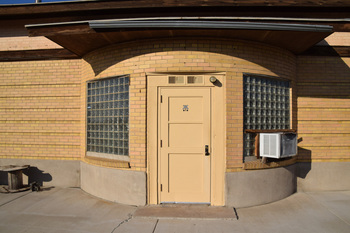 : bay window details
: bay window detailsThis is one of the Rio Grande original structures remaining along its route in Utah; the depot at Green River, Utah.
According to D&RGW Depots Vol.2 by Clive & David Carter, this structure was built in 1944 with brick and originally had flat roof; gabled roof today is a later addition no earlier than Aug. 1967[1]. During the flat roof era, eaves used to go around the structure at the position shown by the wooden border in the photo.
Rio Grande Zephyr made a stop, and Amtrak California Zephyr makes a daily stop from May 1997 to this day. Unfortunately, however, Amtrak doesn’t use the structure. It seems UP uses it only as storage.
Photos were taken on Sep. 11, 2014, and Sep. 9, 2017.
[1] Gravity Station Network in Utah-1967;
* 1954 photo of the depot with flat roof;
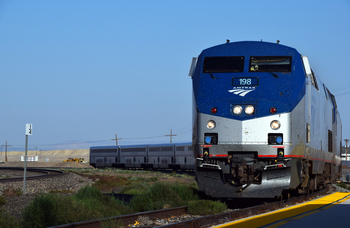 : No.6 arriving Green River
: No.6 arriving Green River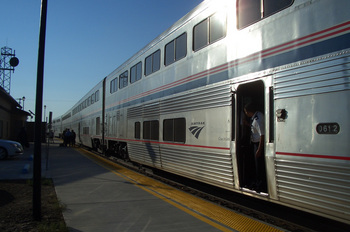 : No.6 at Green River
: No.6 at Green River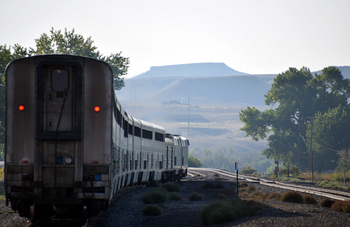 : No.6 departing Green River
: No.6 departing Green River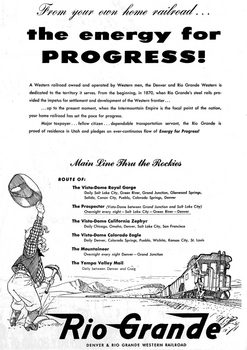 : Jul. 21, 1955 Green River Journal
: Jul. 21, 1955 Green River Journal2015-06-12 09:00
コメント(0)
Highway Crossing Sign, Green River [DRGW Facilities PA]
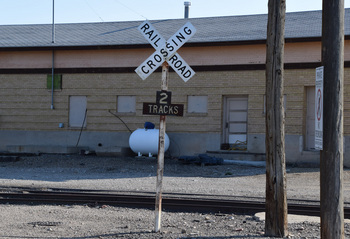 : Green River, UT Sep. 10, 2014
: Green River, UT Sep. 10, 2014I believe this crossbuck found at Green River is a Rio Grande original.
Black letters on white plate “Highway Crossing Sign” with black letters on white plate “Number of Tracks Sign” on 4”x4” wood post is approved in D&RGW Standard Plans[1].
But the 1981 photo of white letters on black plate “Highway Crossing Sign” at Mayville, CO is found in the book Rio Grande in Color Vol. 5[2]. Also is that photos of white letters on black plate “Number of Tracks Sign”s are found in other books. Accordingly, exceptions were existed, as usual. So, this white letters on black plate “Number of Tracks Sign” at Green River may also be accepted.
The crossbuck found at East Carbon shown below seems its “Highway Crossing Sign” replaced, maybe according to UP practice. Letters are a little bolder than the original, and the reflecting material of the plate seems advanced. Above all, Rio Grande original sign should have both plates on the same face of wood post. The crossbuck found at Thompson Springs seems also renovated in the same manner.
[1] D&RGW Standard Plans of Highway Crossing Sign;
[2] Rio Grande in Color Vol. 5 by T. Morris;
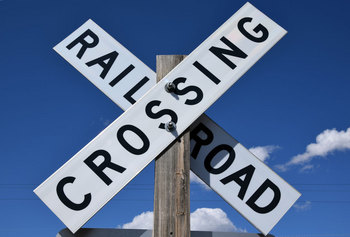 : East Carbon, UT Sep. 10, 2014
: East Carbon, UT Sep. 10, 2014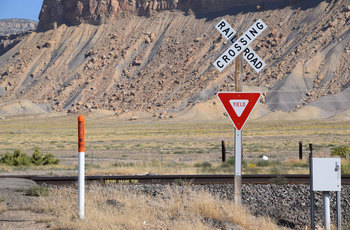 : Thompson Springs, UT Sep. 11, 2014
: Thompson Springs, UT Sep. 11, 20142015-07-11 09:00
コメント(0)
Grade Crossing Signal, Thompson [DRGW Facilities PA]
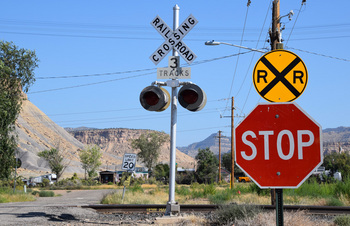 : Thompson Springs, UT Sep. 11, 2014
: Thompson Springs, UT Sep. 11, 2014I believe this grade crossing signal found at Thompson Springs is the Rio Grande original.
A photo of the same signal taken in the 80’s is found in the book Rio Grande RULER OF THE ROCKIES by R. Farewell. It also leans a little to the right in the book. The only transition is the color of “Number of Tracks Sign”; it used to be white letters on black plate those days.
I have no idea whether these signals shown below, found along US Hwy 6 & 89, are Rio Grande original or not.
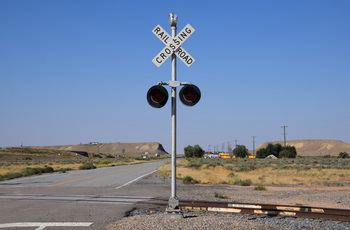 : Brendel, UT Sep. 11, 2014
: Brendel, UT Sep. 11, 2014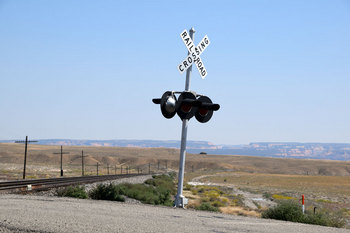 : Cisco, UT Sep. 11, 2014
: Cisco, UT Sep. 11, 2014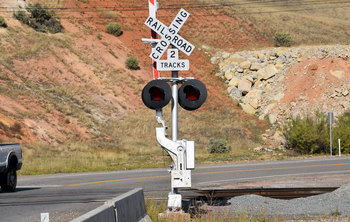 : Thistle, UT Sep. 15, 2014
: Thistle, UT Sep. 15, 20142015-07-12 09:00
コメント(0)
Highway Overpass, Green River [DRGW Facilities PA]
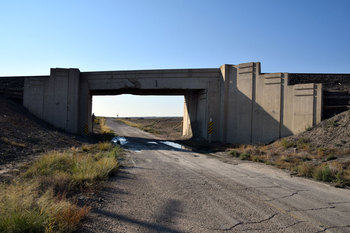 : Green River, UT Sep. 11, 2014
: Green River, UT Sep. 11, 2014This is one of the Rio Grande original structures remaining along its route in Utah; the viaduct.
This Art Deco style overpass, built in the late 30’s, is found on old US Hwy 6 east of Green River, Utah[1]. A photo in the book Rio Grande Secret Places Vol.2 shows the viaduct with flying Rio Grande logo plate installed[2]. Unfortunately, however, the plate is gone today, and what appeared is the old sans-serif letterings “RANDE” long been hidden behind the logo plate.
All photos were taken on Sep. 11, 2014.
[1] as new photo of the similar structure built in 1938, located on old US Hwy 6 west of Green River;
[2] R. C. Farewell, Rio Grande Secret Places Vol.2, Colorado Railroad Historical Foundation, 1999;
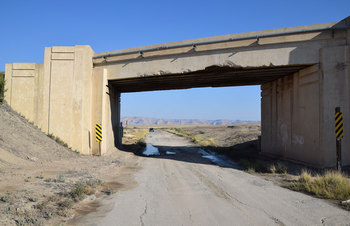 : looking from the south
: looking from the south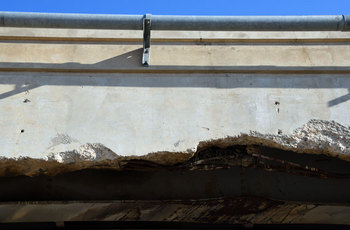 : old letterings
: old letterings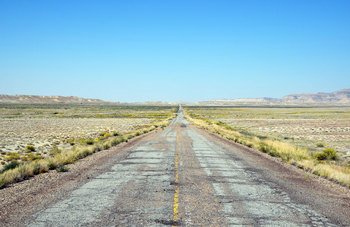 : old US Hwy 6 east of Green River
: old US Hwy 6 east of Green River2015-07-13 09:00
コメント(0)
Thompson Wash Bridge [DRGW Facilities PA]
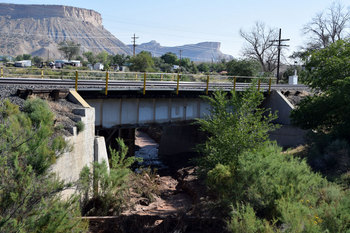 : Thompson Springs, UT Sep. 11, 2014
: Thompson Springs, UT Sep. 11, 2014This is one of the Rio Grande original structures remaining along its route in Utah; the bridge at Thompson Springs, Utah.
This single span steel plate girder bridge spanning Thompson Wash is found just west of the depot. The deck plate girder holding the main track was built in 1901 by American Bridge Co. of Chicago Il. Flying Rio Grande logo is barely seen under the covering paint.
The additional Support at the center of the span is of another bridge holding the siding; it spans the wash in two deck plate girders.
* Bridgehunter web page with look up view of the bridge;
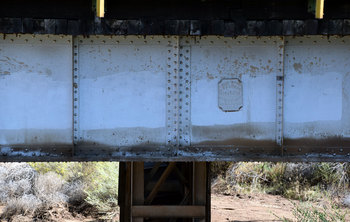 : Thompson Springs, UT Sep. 11, 2014
: Thompson Springs, UT Sep. 11, 20142015-07-14 09:00
コメント(0)
Thompson Depot [DRGW Facilities PA]
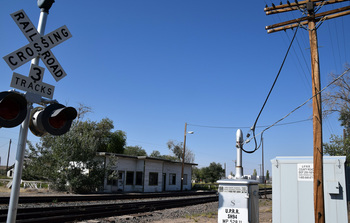 : Thompson Springs, UT Sep. 11, 2014
: Thompson Springs, UT Sep. 11, 2014I’m representing the Rio Grande remnants we found during our vacation in Utah.
This is one of the Rio Grande original structures remaining along its route in Utah; the depot at Thompson Springs, Utah.
According to D&RGW Depots Vol.2 by Clive & David Carter, Thompson Depot was built in 1945, replacing the old depot built in 1883[1]. The cinder block walls are finished with asbestos-cement shingle siding, roof with tar-gravel: same to the depot built in 1947 at Olathe, CO. The book Moab and Grand County has an as new photo of the depot[2]. It seems painted red when it was built[3].
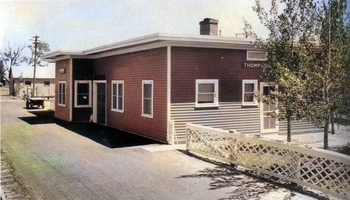 : automatically colorized photo of the as new depot appears in the book "Moab and Grand County"
: automatically colorized photo of the as new depot appears in the book "Moab and Grand County"California Zephyr used to make a stop at the depot, but it went to flag-stop status in 1960[4, 5]. Its successor Amtrak California Zephyr also used to make a stop until when it moved to Green River: the last passenger train departed Thompson on May 12, 1997, [6]. Since, the depot seems used as storage.
Commercial phone number for the agent was Thompson 4121, later 285-2221 according to the 1974-1975 Continental Telephone Company of Utah telephone directories: company phone number for the agent was GJ 65 or GJ 77-104[7].
There used to be a water tank painted silver with the flying logo opposite the track on the east side. The back cover of the journal Canyon Legacy Vol. 50 has a photo of the depot, tank and the freight depot[8].
The tank was removed and relocated to nearby reservoir in 1958[9, 10].
Freight depot was next to the tank on the east side. It was built in 1889 and retired in 1972[11]. Next to the freight depot to the east along the siding was the Kennecott Copper's acid plant[12].
All photos taken on Sep. 11, 2014
[1] 1940 photo of the depot built in 1883;
[2] Travis Schenck, Moab and Grand County, Arcadia Publishing, 2013
[3] Neural Network-based Automatic Image Colorization project site;
[4] Nov. 28, 1957 Times-Independent
[5] Apr. 27, 1960 Times-Independent
[6] Amtrak Stations Database, USA Rail Guide;
[7] Rio Grande System Telephone Directory, May 1967
[8] Canyon Legacy Vol. 50, Dan O'Laurie Canyon Country Museum, spring 2004
[9] Oct. 16, 1958 Times-Independent;
[10] Dec. 10, 1964 Times-Independent;
[11] 1972 photo of the freight depot;
[12] Jul. 30, 1970 Times-Independent;
* Rezuke, John (1994) "Amtrak's California Zephyr in Eastern Utah 1994" YouTube;
* Stiles, Jim, (2021) Poking Through the Ruins #2, Dec/Jan 2022, The Canyon County Zephyr;
Postscript; according to Feb. 4, 2016 Times-Independent, the structure was demolished in January 2016.
revised, Feb. 22, 2016
revised, Apr. 17, 2017
revised, Jun. 7, 2017
revised, Jan. 18, 2018
revised, Jun. 8, 2020
revised, Dec. 9, 2021
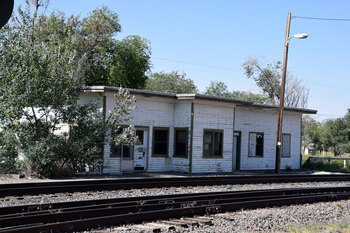 : north elevation
: north elevation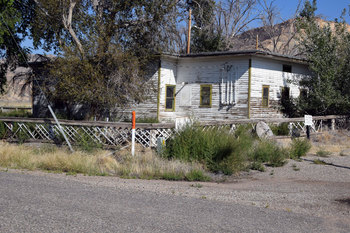 : south & east elevation
: south & east elevation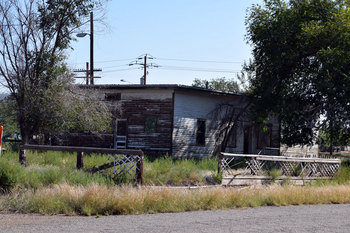 : west & south elevation
: west & south elevation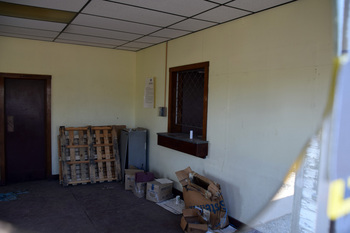 : waiting room interior seen through the door
: waiting room interior seen through the door2015-07-31 09:00
コメント(0)
Thompson Company House [DRGW Facilities PA]
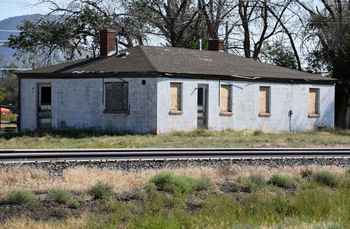 : looking from southwest
: looking from southwestThis is one of the Rio Grande original structures remaining along its route in Utah; the company house at Thompson.
This structure stands opposite the depot, on the north side of the track. It is a one-story cinder block structure of 26’ x 49’6” (if I count the joints), with hip shingles roof. Four doorways facing three directions suggest the structure's multipurpose. It has no sign or lettering, but the same green paint with the depot barely remains at the eaves shows its origin.
According to the ICC valuation map, this structure was built in 1949 as "Sec. Hse". 1952 USGS aerial photo clearly shows this structure.
According to the long-time Thompson resident AJ Rogers, this structure is called The Apartments, a duplex with two one-bedroom homes for section hands' family. AJ remembers Lucilo (1906 - 1999) and Marie Lena Lina Ramirez (1914 - 1989) Aguilera family occupied the home from the 60s to the 70s; Lucilo was the section hand.
Unfortunately, however, it seems not used by UP today; it is no wonder UP is going to demolish it. Accordingly, I drew plans of the structure referring to the results of my survey to keep some records.
All photos were taken on Sep. 11, 2014.
Postscript; the structure was demolished in January 2016.
revised, Sep. 13, 2016
revised, Mar. 15, 2018
revised, Mar. 4, 2022
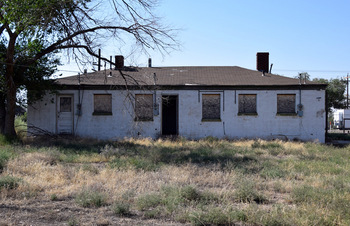 : north elevation
: north elevation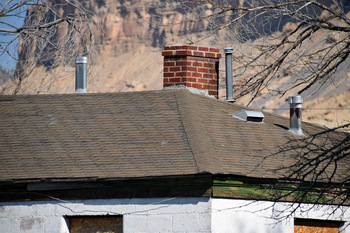 : green paint on eaves
: green paint on eaves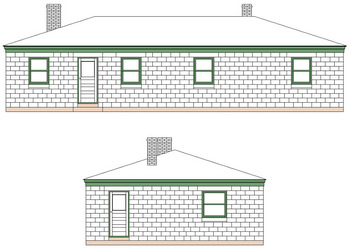 : south and west elevation
: south and west elevation2015-08-01 09:00
コメント(0)
Thompson Section Tool House [DRGW Facilities PA]
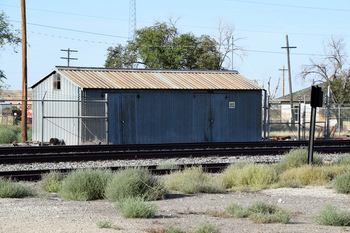 : Thompson Springs, UT Sep. 10, 2017
: Thompson Springs, UT Sep. 10, 2017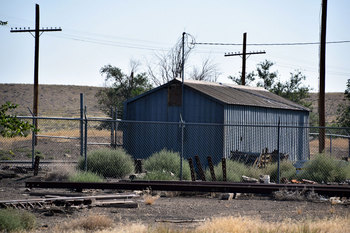 : Thompson Springs, UT Sep. 11, 2014
: Thompson Springs, UT Sep. 11, 2014This is one of the Rio Grande original structures remaining along its route in Utah; the section tool house at Thompson.
This section tool house has doorway doubled to Rio Grande standard plan[1]. It seems still used by UP, surrounded by net fence and junks.
[1] D&RGW Standard Plans of Section Tool House;
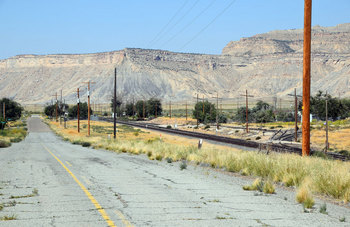 : Thompson Springs, UT Sep. 11, 2014
: Thompson Springs, UT Sep. 11, 20142015-08-02 09:00
コメント(0)
Rio Grande Ave, Marysvale [DRGW Facilities PA]
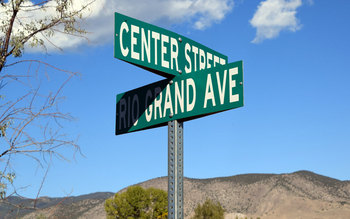 : Marysvale, UT Sep. 15, 2014
: Marysvale, UT Sep. 15, 2014I’m representing the Rio Grande remnants we found during our vacation in Utah.
I believe this is one of the Rio Grande remnants; Rio Grande Ave at Marysvale. Depot St or Railroad St is common for the railroad-related street name in a town. I think the street crowning the name of a railroad is unique. Google Maps tells us that Salt Lake City and Midvale also have Rio Grande St in Utah.
Here, at Marysvale, the street connecting the depot and the center of the town is named Rio Grande Ave. The town was the terminus of Marysvale Branch.
Marysvale Branch was a 132.8 miles standard gauge branch diverting south at Thistle, Utah. It reached Marysvale in 1900. The 1983 massive landslide at Thistle forced the railroad to abandon the branch. It was formally abandoned in 1986. But the last of regular train service to Marysvale was much earlier; Marysvale saw the last train in 1972[1].
Nothing but the street name still lives on at Marysvale today. Little hut in front of the Moore’s Old Pine Inn is said to be the depot; might have been cut from the original structure which measured 192’ long. The former depot site is covered with bush, and the right of way stretching 0.6 miles from the depot to the very end of the track at the alunite reduction mill is fading into nature, as you can see in the photo below[2, 3].
All photos were taken on Sep. 15, 2014.
revised, Mar. 18, 2019
[1] DRGW NET web page;
[2] 1985 photo of the very end of the track;
[3] Strack, Don, (2019) "Marysvale Alunite", utahrails.net;
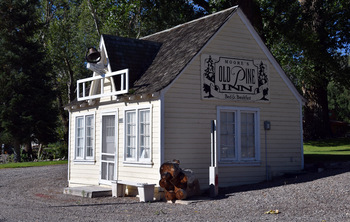 : part of former depot
: part of former depot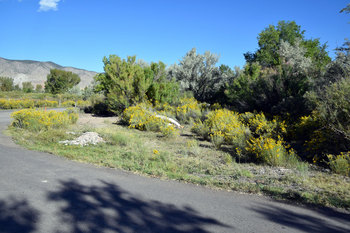 : former depot site
: former depot site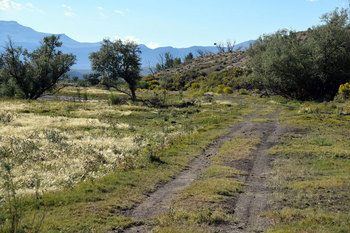 :the right of way toward the very end of track
:the right of way toward the very end of track2015-09-05 05:00
コメント(0)
Richfield Depot [DRGW Facilities PA]
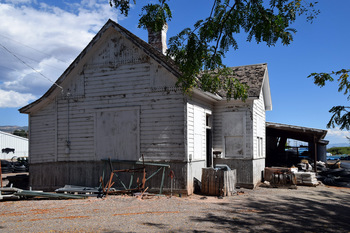 : Richfield, UT Sep. 15, 2014
: Richfield, UT Sep. 15, 2014I’m representing the Rio Grande remnants we found during our vacation in Utah.
This is one of the Rio Grande original structures remaining along its route in Utah; the depot at Richfield.
According to the book D&RGW Depots Vol.2 by Clive & David Carter, Richfield Depot was built in 1896, with wood frame and roof finished with wood shingles, walls finished with drop siding with a beaded wainscot. It was retired in 1985, and since used as storage by Peterson Plumbing Supply. It still keeps wonderful decoration on gables. I believe this is the only depot along Marysvale Branch existing at its original site.
According to the book Rio Grande in Color Vol.5, Richfield was the terminus of regular train service in the 70’s. The crews left Salt Lake City at ten in the evening, usually with two GP40s. They reached Richfield next morning, and started back to Salt Lake City at six in the evening that day.
* 1896 photo of the depot (as new);
* 1921 photo of the depot;
* 1975 photo of the depot;
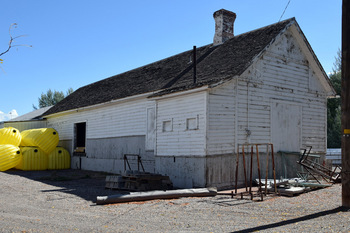 : Richfield, UT Sep. 15, 2014
: Richfield, UT Sep. 15, 2014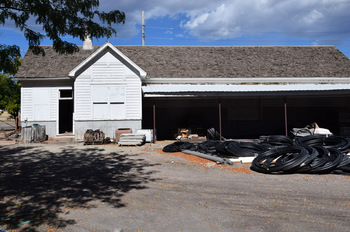 : Richfield, UT Sep. 15, 2014
: Richfield, UT Sep. 15, 20142015-09-26 09:00
コメント(0)
Sigurd Depot [DRGW Facilities PA]
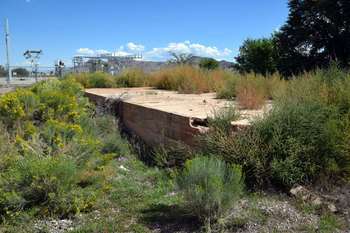 : Sigurd, UT Sep. 15, 2014
: Sigurd, UT Sep. 15, 2014I’m representing the Rio Grande remnants we found during our vacation in Utah.
This is one of the Rio Grande original structures remaining along its route in Utah; the depot at Sigurd.
According to D&RGW Depots Vol.2 by Clive & David Carter, Sigurd Depot made of wood frame was built in 1920, and was retired in 1978. The book Rio Grande in Color Vol. 2 has a clear 1970 photo of the depot. The depot was once the busiest in the branch, shipping more than 100,000 tons of wallboard a year from nearby plant.
Though the structure is gone, the basement still exists at the original site in the center of cornfield. You can trace the waiting room/office/freight room arrangement of the depot. Old rails used for the floor joists peeping out from the concrete.
All photos taken on Sep. 15, 2014
* 1970 photo of the depot;
* 1976 photo of the depot by Dick Harrison;
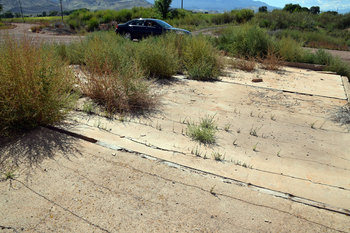 : from the distant: waiting room, office and freight room
: from the distant: waiting room, office and freight room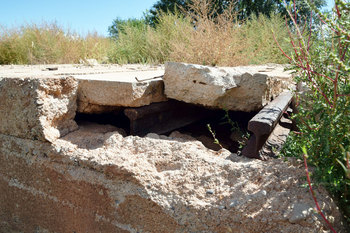 : rails used for the joists peep out from the floor
: rails used for the joists peep out from the floor2015-10-04 09:00
コメント(0)
Rio Grande Remnants in Utah 18 – Jumbo Mill Spur, Sigurd [DRGW Facilities PA]
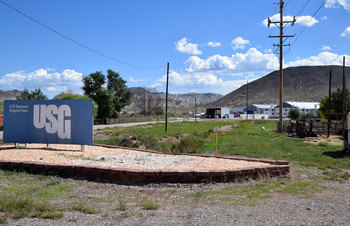 : Sigurd, UT Sep. 15, 2014
: Sigurd, UT Sep. 15, 2014I’m representing the Rio Grande remnants we found during our vacation in Utah.
There used to be a spur diverting east from Sigurd depot to the wallboard plant of Jumbo Plaster and Cement Company. The plant produced largest single commodity of more than 100,000 tons of wallboard in a year for this branch. The plant is still active and operated by USG today.
1951 Rio Grande General Freight Traffic Department Circular map shows the spur as Jumbo Mill Spur. Today, there is nothing left but the right of way as you can see in the photo below.
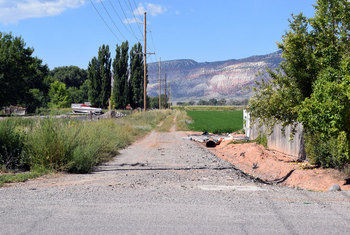 : Sigurd, UT Sep. 15, 2014
: Sigurd, UT Sep. 15, 20142015-10-05 09:00
コメント(0)
Mount Pleasant Depot [DRGW Facilities PA]
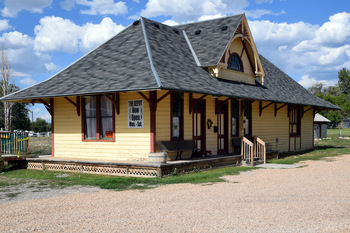
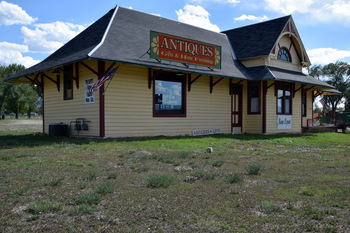
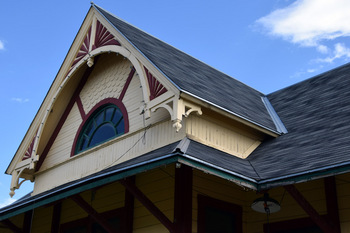
I’m representing the Rio Grande remnants we found during our vacation in Utah.
This is one of the Rio Grande original structures remaining along its route in Utah; the depot at Mt. Pleasant.
According to D&RGW Depots Vol.2 by Clive & David Carter, Mt. Pleasant Depot was built in 1890 with wood frame and roof finished with wood shingles, walls finished with V-joint with beaded wainscot. It was retired in 1986 and moved to this site in 2001.
In front of the depot sits a wooden caboose, maybe a Northern Pacific reminder; NPRY name and 11-39 date cast on track. All photos taken on Sep. 15, 2014.
* 1946 photo of the depot;
* documents of preservation works;
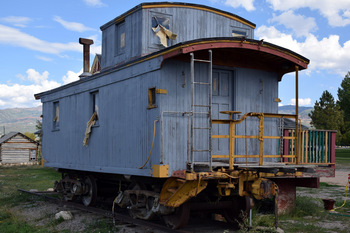
2015-10-31 09:00
コメント(0)
Salt Lake City Union Station [DRGW Facilities PA]
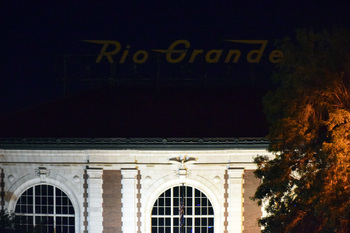 : Salt Lake City, UT Sep. 15, 2014
: Salt Lake City, UT Sep. 15, 2014I’m representing the Rio Grande remnants we found during our vacation in Utah.
This is one of the Rio Grande original structures remaining along its route in Utah; the station at Salt Lake City.
The station stands on Rio Grande St at the end of Broadway, like the symbol of the city. Unfortunately, however, the flying Rio Grande logo neon sign on the roof was not lit when we visited at 9 pm.
There used to be the Western Pacific neon sign under the Rio Grande sign as you can see in the postcard below. The structure now houses Utah State Historical Society.
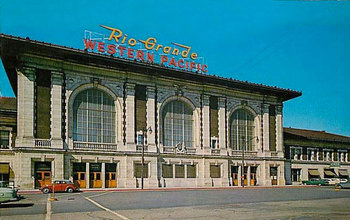 : postcard maybe printed in the 50’s
: postcard maybe printed in the 50’s2015-11-13 09:00
コメント(0)
Santa Fe Depot [DRGW Facilities PA]
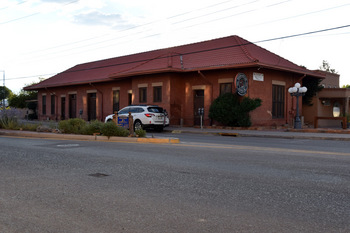 : Santa Fe, NM. Sep. 13, 2015
: Santa Fe, NM. Sep. 13, 2015I’m representing the Rio Grande remnants we found during our vacation in New Mexico.
This is one of the Rio Grande original structures remaining in New Mexico; the depot at Santa Fe.
According to D&RGW Depots Vol.2 by Clive & David Carter, Santa Fe Depot was built in 1904 with brick walls and roof finished with red tiles. It was retired in 1941 and it houses a restaurant today. Right in the photo below is the former ATSF depot.
* 1965 photo of the depot by James(Jim) Ozment;
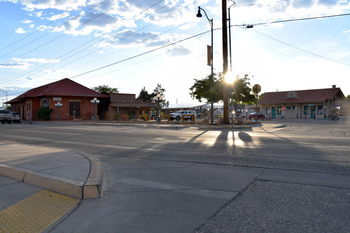 : Santa Fe, NM. Sep. 13, 2015
: Santa Fe, NM. Sep. 13, 20152016-06-10 09:00
コメント(0)
Thompson Section House [DRGW Facilities PA]
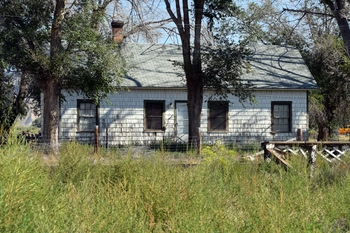 : looking from the south
: looking from the south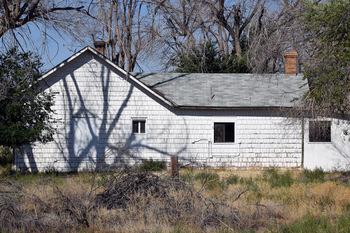 : looking from the east
: looking from the east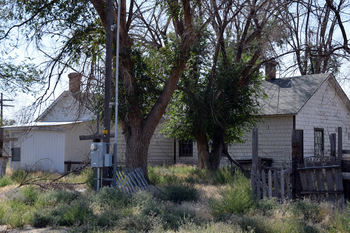 : looking from the northwest
: looking from the northwestThis was one of the Rio Grande original structures that remained along its route in Utah; the section house at Thompson.
ICC valuation map of by then Thompson’s Station, drawn in 1919 and revised in 1927, shows this structure. According to the map, this, 40’ x 40.5’ one-story wood-frame structure, gable roof, and walls finished with straight cut singles, is the section house.
Smaller D&RGW bunkhouse at Chama, NM has a similar façade: a door and four windows in symmetrical order. It was built in 1881, ten years prior to the depot. D&RGW section house at Sublette, NM also has a similar façade. It was built in 1880, two years prior to the depot. Accordingly, this section house may be built prior to the original Thompson depot which was built in 1883.
The book Moab and Grand County barely shows the structure in the photo may be taken in the ’30s[1]. In the photo, we can see wainscot. Accordingly, straight cut singles on walls we see in the photo must have been the later modification.
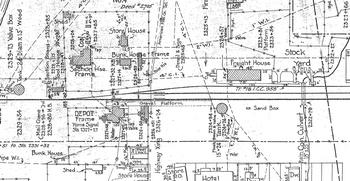 : part of ICC valuation map showing the section house, courtesy of Utah State Archives
: part of ICC valuation map showing the section house, courtesy of Utah State ArchivesSection foremen were assigned at Thompson since its establishment. Depot housed the agents, bunkhouse accepted the section hands, and later, signal maintainers had their housing next to the track on the south[2, 3]. Accordingly, this structure must have housed successive section foremen.
Extracted successive section foremen assigned at Thompson are:
John McCartin in 1892[4].
J. U. Coleman(1868 – ), John H. Brady(1849 – ), A. F. Crispin(1856 – ), S. P. Brown(1863 – ) and James Ryan(1856 – ) in 1900[5].
Maurice Sullivan Sr. in 1908[6].
Antonio Cianio(1878 – ), Peter Colombas(1892 – ), Luciano Cesario(1894 – ) and Joe R. Dimas(1897 – ) in 1920[7]. Luciano was also placed here in 1930[8].
Geo Saker in 1933[9].
James M. Noblitt(1892 – 1967) at least from 1940 to 1958[10, 11]. But whether he was assigned at Thompson or Cisco is uncertain: 1940 Census lists four names including James as section foremen at Cisco[10]. 1950 Census lists James, Theodore Herman "Ted" Miller (1912 – 1990), and Glenn William Marler(1924 – 2016) as foremen at Thompson, but only James and his wife Eva(1886 – 1964) must have been lived in this house at that time[12].
"Ted" Miller was assigned at Thompson since the '40s, at least from 1964[13, 14]. He and his spouse Lillian "Nana" Lois Sando (1914 – 1996), their children Bill, Sharon, Bruce, and Lillian's grandmother lived in this house. Lillian worked as a waitress at the Silver Grill Cafe opposite the depot. Ted finally retired from the railroad in 1977, but kept living in this house to the '80s [13, 15]. Millers seems the last occupant of this house.
The company telephone number for Thompson Section was GJ 77-155, according to Rio Grande System Telephone Directory issued in January 1973. Ted Miller also had the public phone 285-2245 according to the 1974-1975 Continental Phone Company of Utah telephone directories.
Unfortunately, the structure was demolished together with the depot in 2016. To leave something on record, I decided to draw plans of the structure. The result is shown below.
All photos taken on Sep. 11, 2014.
revised, Jun. 7, 2017
revised, Feb. 21, 2020
revised, Jun. 8, 2020
revised, Jul. 24, 2022
[1] Schenck, Travis (2013) Moab and Grand County, Arcadia Publishing
[2] Jul. 13, 1960 Times-Independent;
[3] Dec. 10, 1964 Times-Independent;
[4] Mar. 9, 1893 Provo Daily Enquirer;
[5] 1900 Census;
[6] Mar. 28, 1908 Emery County Progress;
[7] 1920 Census;
[8] 1930 Census;
[9] Feb. 2, 1933 Times-Independent;
[10] 1940 Census;
[11] Apr. 13, 1967 Times-Independent;
[12] 1950 Census;
[13] Feb. 14, 2020 Times Independent;
[14] Dec. 24, 1964 Times-Independent;
[15] Mar. 2, 1977 Times-Independent;
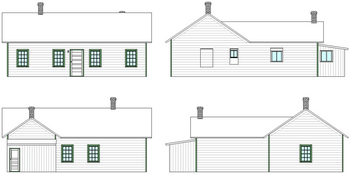 : south, east, north and west elevations
: south, east, north and west elevations2017-04-28 09:00
コメント(0)
Arboles Water Tank [DRGW Facilities PA]
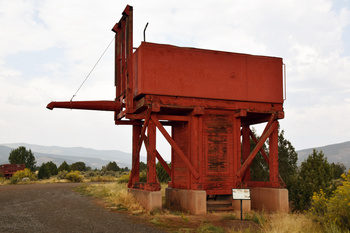
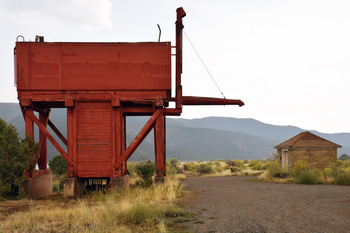
This is one of the Rio Grande original facilities remain along its route in Colorado; the water tank at Arboles.
The water supply facilities here at Arboles is quite simple compared with that at Cisco, Utah. The source is a few feet from the track. Moreover, they have no coalhouse or pumper’s dwelling since 1962, as the facilities were relocated that year due to the construction of Navajo Dam.
The unusual water tank was made from the tender of M-75 class steam locomotive #1600[1]. As the locomotive was scrapped in 1949, the tank seems the product of that time.
According to the barely remaining flying Rio Grande logo on it, the crew chopped the coal bunker and front-end off, then tucked engineer’s side into and formed the new front-end. Inside the wall under the tank contains only piping. The paint color is later alteration.
Wood frame structure lapped with brick pattern tarpaper seems the shed, not the pump house because of its position: it also lacks marks of the smoke stack. The structure was also relocated. According to the old photo, it originally stood next to the tank on the same side of main track[2]. The facilities were retired collectively in 1968.
All photos were taken on Sep. 7, 2017
[1] Holmes, Nathan (2007) “Arboles, CO”, DRGW.NET;
[2] photo of the tank before relocation found at Friend of Cumbres & Toltec Scenic Railroad webpage;
* photo of M-75 class steam locomotive with flying Rio Grande logo;
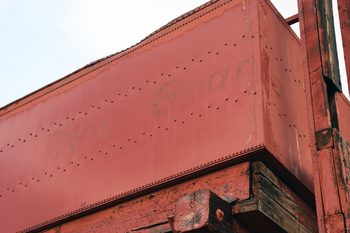
2017-12-15 09:00
コメント(0)
Colorado River Bridge [DRGW Facilities PA]
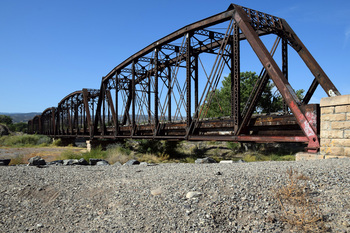 : Sep. 11, 2017 Grand Junction, CO
: Sep. 11, 2017 Grand Junction, COThis 730 feet 5 span Parker(camelback) through truss bridge spans the Colorado River at Grand Junction, Colorado[1]. It seems built in 1903 to haul by-then D&RG narrow-gauge route between Montrose and Grand Junction completed in 1882. The route was later standard gauged in 1906.
We can find some weird constructions in this bridge:
First of all, the portal strut slips off the top chord. The portal strut-and-bracing set is mounted to the end post through thin gusset plates sticking out from the top chord. The set itself looks like a substitute, as the member used is different from the others.
Also is that lateral bracing is in two stages; it looks like another lateral strut and the bracing set added to the original lateral bracing. The member and style of lateral bracings are completely different from each other.
But these distinctive features already appear in the under construction photo; these prove the weird constructions are not the later modification[2].
The bridge was one of the longest in the entire D&RGW system. And, maybe is one of the oldest among surviving D&RGW iron bridges, too.
revised, May 2, 2018
[1] Baugan, James “UP – Colorado River Bridge (Grand Junction)” Bridgehunter.com web page;
[2] Anderson, George Edward (1903) “Iron Bridge, 5 Men and Boiler” Brigham Young University Library;
* Ozment, James (1960) “bridge on Colorado River @ Grand Junction” Western Rail Images web page;
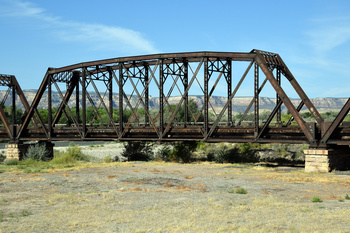 : Sep. 11, 2017 Grand Junction, CO
: Sep. 11, 2017 Grand Junction, CO2018-02-23 09:00
コメント(4)
Timber Trestle Bridges on D&RGW Creede Branch [DRGW Facilities PA]
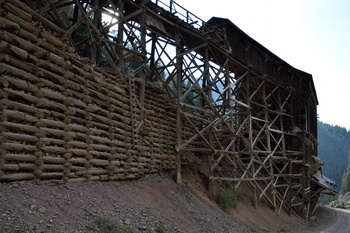 : Commodore Mine, Creede, CO.
: Commodore Mine, Creede, CO.Here, the term bridge is "a structure that carries transportation infrastructure over an obstruction" and the term trestle is "a rigid framework using pairs of legs to support a bridge".
The photo above shows the familiar type of timber trestle bridge found at a mine near Creede, CO. Timbers were also heavily used to build structures in this part of D&RGW network in southern Colorado. But the timber trestle bridges on D&RGW Creede Branch show another type. Here you see how different they are:
Bridge built in 1892 at milepost 312.72 spanning namesake Rio Grande near Wagon Wheel Gap shows the example. This ten span girder bridge has heavy timber stringers. Trestles made of piles and timbers are covered with planks to the top like a snowplow to let pass through various things floating down the river.
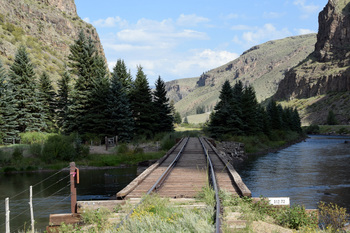
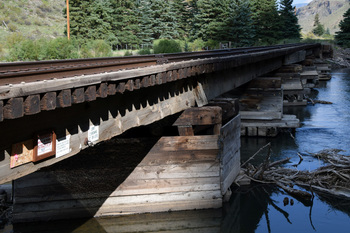
The trestles of the similar bridge further up the Rio Grande east of Wasson wye are half way covered up with planks, as the trestles are taller than the former. This bridge was also built in 1892. Notice the telephone booth/outhouse on the bank.
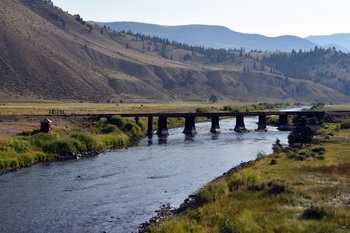
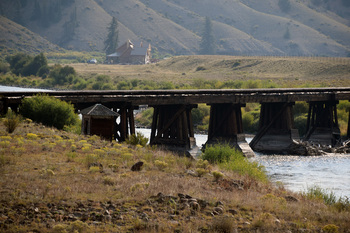
It seems the raging mining development upper stream caused substantial driftwoods. My idea is that D&RGW chose not familiar type but long span bridges with lesser trestles arranged parallel to the stream to avoid driftwoods to be piled up. The snowplow-like covers added on trestles are the grounds of my idea.
All photos were taken on Sep. 7, 2017
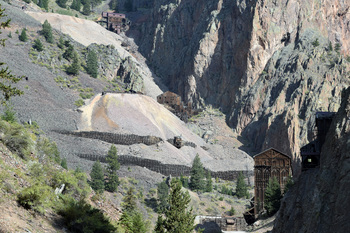 : results of mining development at Creede, CO.
: results of mining development at Creede, CO.2018-03-02 09:00
コメント(0)
Creede Depot [DRGW Facilities PA]
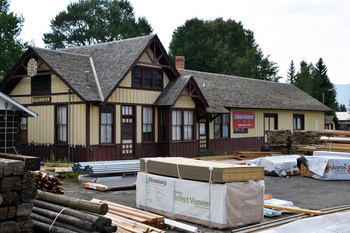
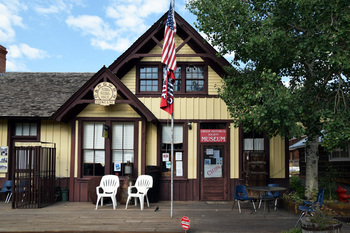
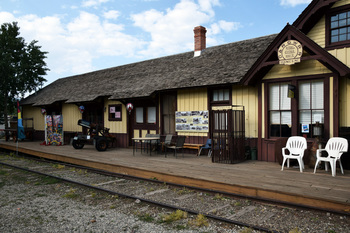
This is one of the Rio Grande original facilities remained along its route in Colorado; the depot at Creede.
According to Denver & Rio Grande Western Depots Volume 2 by Clive Carter, Creede depot was built in 1893 with one-story frame structure of wood singles roof, board and batten wall and wood singles gable ends. It was retired in 1961. Today, museum occupies the structure.
Former right of way in front of the depot is used as lumber yard by a local building material supplier. Two-room outhouse also survives to this day.
The branch reached Creede in 1892 and converted to standard gauge in 1902[1]. The last train left the depot in 1969, and the segment between Creede and South Folk was abandoned in 1999.
The county seat of Mineral County, former mining town Creede was incorporated in 1892, the same year rail reached the town. The mines behind the town produced gold, silver and copper, later lead and zinc ores until 1985.
All photos taken on Sep. 7, 2017
[1] Holmes, Nathan D., (2009) “D&RG/D&RGW Creede Branch History” DRGW.Net;
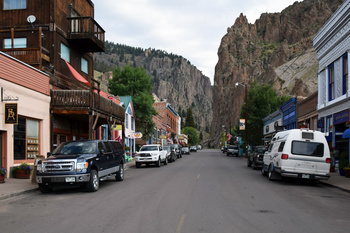 : N Main St & Wall St, Creede
: N Main St & Wall St, Creede2018-03-09 09:00
コメント(0)
Wagon Wheel Gap Depot [DRGW Facilities PA]
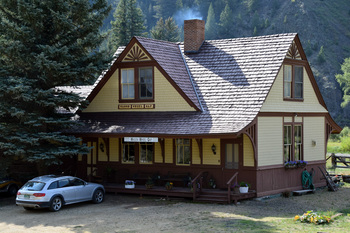
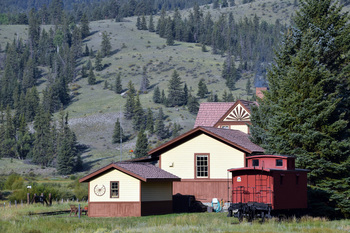
In 1883, Rio Grande built sixteen depot structures[1]. Among them, three depot structures are surviving to this day: Wagon Wheel Gap, Crested Butte, and Santa Fe. I previously represented Santa Fe depot. This time, I’ll introduce the rests surviving in Colorado. The purpose is to clarify the appearance of the depot at Cisco, Utah, which seems first built same year.
This is one of the Rio Grande original facilities remained along its route in Colorado; the depot at Wagon Wheel Gap.
According to Denver & Rio Grande Western Depots Volume 2 by Clive Carter, Wagon Wheel Gap depot was built in 1883 with the two-story frame structure of wood shingles roof and drop siding walls. It was retired in 1954.
The depot structure was registered as National Register of Historic Places in 1976[2]. Today, private home occupies the structure[3].
The depot structure published twice, NMRA Bulletin and Model Railroader[4, 5]. Both articles accompany photos and drawings. But, concerning the position of stairs, the drawings represented in Bulletin seem more accurate.
The branch reached Wagon Wheel Gap in 1883 and converted to standard gauge in 1902[6]. Wagon Wheel Gap was the gateway to the namesake hot springs located a mile south of the depot. Unfortunately, however, the segment between Creede and South Folk including Wagon Wheel Gap was abandoned in 1999.
All photos were taken on Sep. 7, 2017
[1] Carter, Clive (2013) Denver & Rio Grande Western Depots Vol. 1, 2
[2] National Register of Historic Places Inventory Form;
[3] Mar. 2014 The Newsboy, San Luis Valley Rural Electric Cooperative;
[4] Hanschka, Richard Swerdfeger, Mark D. (1971) “Depot at Wagon Wheel Gap” June 1971 Bulletin, National Model Railroad Association
[5] Hediger, Jim (1988) “D&RGW’s Wagon Wheel Gap station” March 1988 Model Railroader, Kalmbach Publishing
[6] Holmes, Nathan D., (2009) “D&RG/D&RGW Creede Branch History” DRGW.Net;
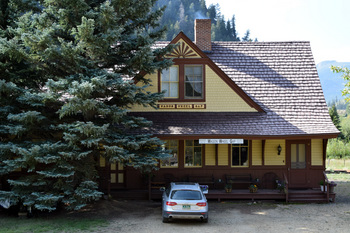
2018-03-23 09:00
コメント(0)
Section Tool House near Wagon Wheel Gap, Colorado [DRGW Facilities PA]
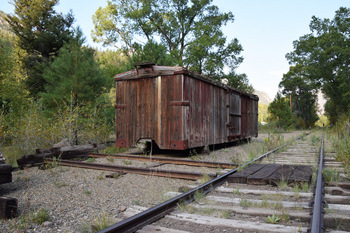
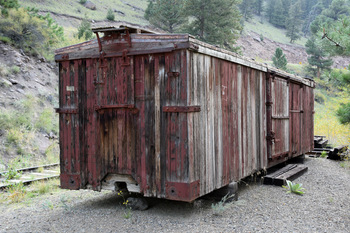
This is one of the Rio Grande original facilities remained along its route in Colorado: the section tool house near Wagon Wheel Gap.
This picturesque old boxcar shed is found on former Rio Grande Creede Branch. Even though the branch was standardized in 1902, this is a narrow gauge car: maybe brought in from Alamosa.
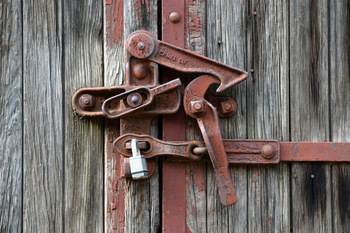
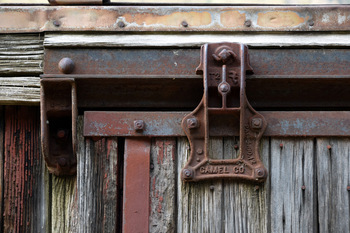
Barely read numbers “34” on side suggest this car as one of DRGW 3000 – 3749 class 30’ XM built by American Car & Foundry in 1904.
As you can see, CAMEL CO relief is found on every hardware. The complicated door latch, called "door-starter" helping the heavy stuck door open, suggests that this particular car was rebuilt in the 20’s[1].
A boxcar from same series but with trucks and “Economy Door” is found at Monte Vista, CO[2]. Another, DRGW #3001 is found at Grand Junction, CO.
All photos were taken on Sep. 2017
[1] National Register of Historic Places Registration Form for D&RGW Boxcar #3132;
[2] Johnson, Jeff (2009) “D&RGW Economy Door Boxcar History”, Blackstone Models webpage;
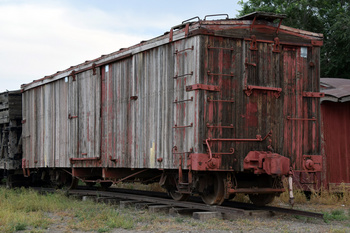
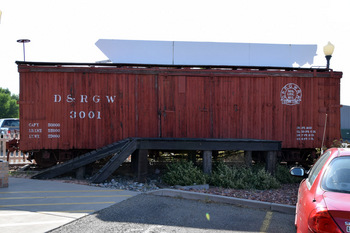
2018-03-30 09:00
コメント(0)
Crested Butte Depot [DRGW Facilities PA]
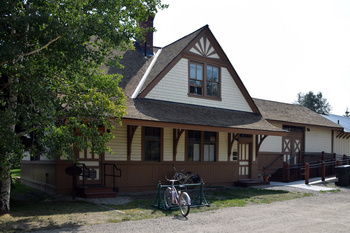
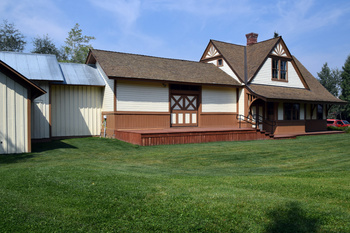
In 1883, Rio Grande built sixteen depot structures[1]. Among them, three depot structures are surviving to this day: Wagon Wheel Gap, Crested Butte and Santa Fe. I previously represented depots at Santa Fe and Wagon Wheel Gap. This time, I’ll introduce the rest. The purpose is to clarify the appearance of depot at Cisco, Utah, which seems first built same year.
This is one of the Rio Grande original facilities remained along its route in Colorado; the depot at Crested Butte.
According to Denver & Rio Grande Western Depots Volume 1 by Clive Carter, Crested Butte depot was built in 1883 with two-story frame structure of wood shingles roof, drop siding walls and wood singles gables. It was retired in 1953.
The depot structure was registered as National Register of Historic Places in 2001[2]. Today, High Country Conservation Advocates occupies the north half, while the south half is available for rent[3]. S scale (1:64) laser-cut wood craftsman kit of the depot is available from Ragg’s to Riches?[4].
The narrow gauge Crested Butte Branch reached Crested Butte in 1881, and was abandoned in 1954[5].
All photos taken on Sep. 6, 2017
[1] Carter, Clive (2013) Denver & Rio Grande Western Depots Vol. 1, 2
[2] National Register of Historic Places Inventory Form;
[3] Town of Crested Butte web page;
[4] Ragg’s to Riches? web page;
[5] Holmes, Nathan D., (2009) “D&RG/D&RGW Crested Butte Branch History” DRGW.Net;
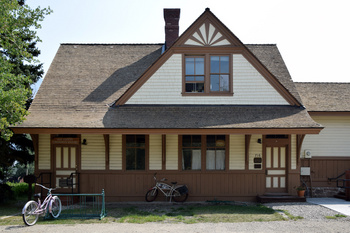
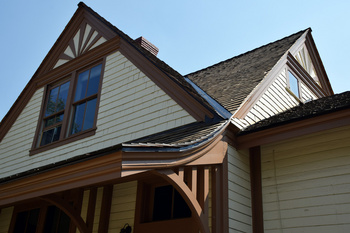
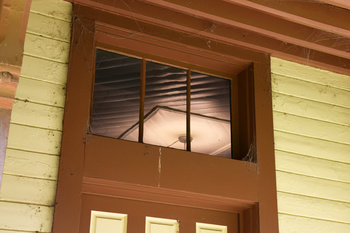
2018-04-06 09:00
コメント(0)
Hooper Depot [DRGW Facilities PA]
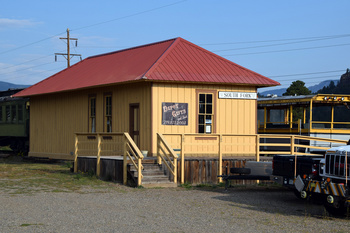
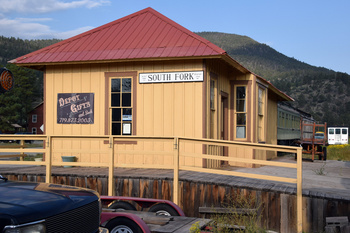
This is one of the Rio Grande original facilities remained along its route in Colorado; the former depot at Hooper now moved to South Fork.
According to Denver & Rio Grande Western Depots Volume 1 by Clive Carter, Hooper depot was built in 1890 with one-story frame structure of wood shingles roof and board & batten walls[1]. It was retired in 1955.
The narrow gauge Valley Line between Mears Junction and Alamosa reached Hooper in 1890[2]. The Line between Hooper and Alamosa was dual gauged in 1930. The Line north beyond Hooper was abandoned in 1951, and the rest of the Line which survived as standard gauge Hooper Spur was finally abandoned in 1959[2].
The depot structure was preserved after the retirement but lost its chimney and the hipped roof above the bay window. In 2008, it was moved to South Fork by Don Shank of Denver and Rio Grande Railroad Historic Foundation: South Fork never had a depot till then[3]. Unfortunately, however, it’s up for sale along with the whole assets as of Sep. 2017.
All photos were taken on Sep. 7, 2017
[1] Carter, Clive (2013) Denver & Rio Grande Western Depots Vol. 1
[2] Holmes, Nathan D., (2009) “D&RG/D&RGW Valley Line History” DRGW.Net;
[3] James, Robin (2008) “South Fork gets railroad depot” Trainorders.com web page;
* Perry, Otto C., (1950) the depot and NG engine #481 at Hooper, Denver Public Library;
* Richardson, Robert W., (1949) the depot and NG engine #497 at hooper, Denver Public Library;
* Perry, Otto C., (1951) the end of track at Hooper, Denver Public Library;
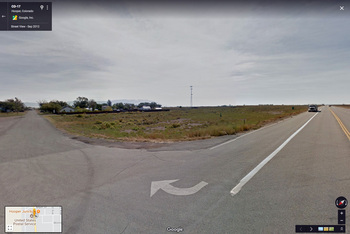 : street view of former depot site
: street view of former depot site2018-04-27 09:00
コメント(0)
Del Norte Depot [DRGW Facilities PA]
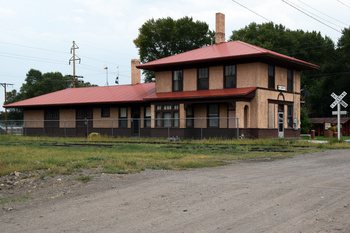
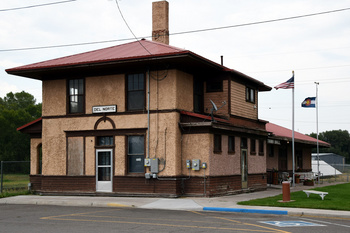
This is one of the Rio Grande original facilities remained along its route in Colorado; the former depot at Del Norte.
According to Denver & Rio Grande Western Depots Volume 2 by Clive Carter, Del Norte depot was built in 1911 with two-story frame structure of wood shingles roof and stucco finish with drop siding wainscot walls[1]. It was retired in 1970. The structure houses the town hall today.
The buried spur extends northeast once served Del Norte Flouring Mill, Del Norte Electric Light Plant & Water Works pumphouse, and Del Norte Creamery Company[2].
The branch reached Del Norte in 1881, and the line between Alamosa and Del Norte was dual gauged in 1901[3]. The branch was sold to San Luis and Rio Grande Railroad in 2003.
revised, Jun. 16, 2018
All photos were taken on Sep. 6, 2017
[1] Carter, Clive (2013) Denver & Rio Grande Western Depots Vol. 2
[2] 1912 Sanborn Map;
[3] Holmes, Nathan D., (2009) “D&RG/D&RGW V Creede Branch History” DRGW.Net;
* photo of the original depot built in 1881 found at Denver Public Library;
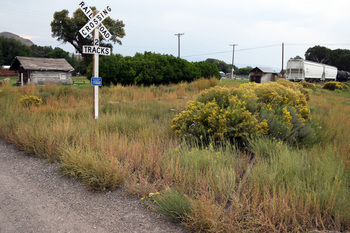 : buried spur at Del Norte
: buried spur at Del Norte2018-05-04 09:00
コメント(0)
Monte Vista Depot [DRGW Facilities PA]
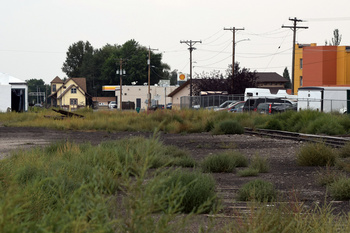
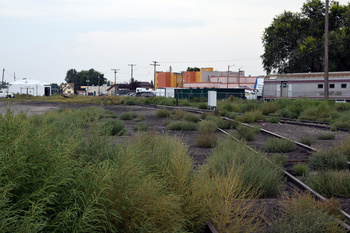 : Sep. 6, 2017
: Sep. 6, 2017This is one of the Rio Grande original facilities remained along its route in Colorado; the depot at Monte Vista.
According to Denver & Rio Grande Western Depots Volume 2, Monte Vista depot was first built in 1886 with the one-story frame structure[1]. In 1907, the second depot was built with the one-story brick structure, and in 1947, it was rebuilt and expanded with cinder blocks. Unfortunately, however, it was retired in 1978.
The structure visible in the distance in the photo above is the replica of Rio Grande Southern’s Mancos depot first built in 1953 by Bob Richardson and Carl Helfin for by-then Narrow Gauge Museum & Motel south of Alamosa.
The museum moved to Golden, CO in 1958 and became Colorado Railroad Museum. The structure itself was relocated, sold, and moved to Monte Vista afterward.
The narrow gauge Creede Branch reached Monte Vista in 1881 and was converted to dual gauge in 1901[2]. The line is operated by San Luis & Rio Grande Railroad since 2003. Barley for Coors is the main commodity shipped from Monte Vista since the Rio Grande era to this day.
[1] Carter, Clive (2013) Denver & Rio Grande Western Depots Vol. 2
[2] Holmes, Nathan D., (2009) “D&RG/D&RGW Creede Branch History” DRGW.Net;
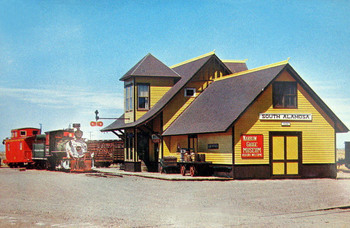 : postcard of Nallow Gauge Museum
: postcard of Nallow Gauge Museum2018-06-29 09:00
コメント(0)



